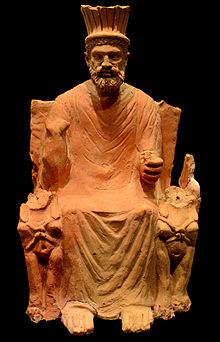Baal Hammon

Baal-Hammon , a name form of Ba'al , is a deity of the Phoenicians or Punians .
It was first mentioned in an inscription from the late Hittite / Aramaic city of Sam'al (today Zincirli ). The name means "Lord of the Incense Altars". He was the main god of Carthage , from where his cult spread to Sicily and Malta. In North Africa, Baal-Hammon was particularly considered the god of fertility. As evidence for this, it is stated that Baal-Hammon was given the epithet Frugifer in Roman times . In Sicily and Africa, child sacrifices were possibly part of his cult, although this has now become less likely due to historical discoveries. His name is similar to that of the Egyptian god Amun , which is why it is assumed that he was an oracle god .
He was equated by the Greeks with Kronos and by the Romans with Saturnus .
literature
- Edward Lipiński : Dieux et déesses de l'univers phenicien et punique (= Studia Phenicia XIV; Orientalia Lovaniensia Analecta 64). Leuven 1995, ISBN 90-6831-690-7 , pp. 59-61, 251-264.
- Paolo Xella: Baal Hammon. Recherches sur l'identité et l'histoire d'un dieu phénico-punique (= Contributi alla storia della religione Fenicio-Punica 1; Collezione di studi fenici 32). Rome 1991.
Individual evidence
- ^ Herbert Niehr: Religion. In: ders. (Ed.): The Aramaeans in Ancient Syria (= Handbook of Oriental Studies Section 1: The Near and Middle East ). Brill, 2014, ISBN 978-9-00422943-3 , p. 158
- ↑ Bluma Trell: Coins of the Phoenician World. In: Waldemar Heckel, Richard Sullivan (eds.): Ancient Coins of the Graeco-Roman World: The Nickle Numismatic Papers. Wilfrid Laurier Univ. Press, 2010, ISBN 978-1-55458699-8 , p. 127